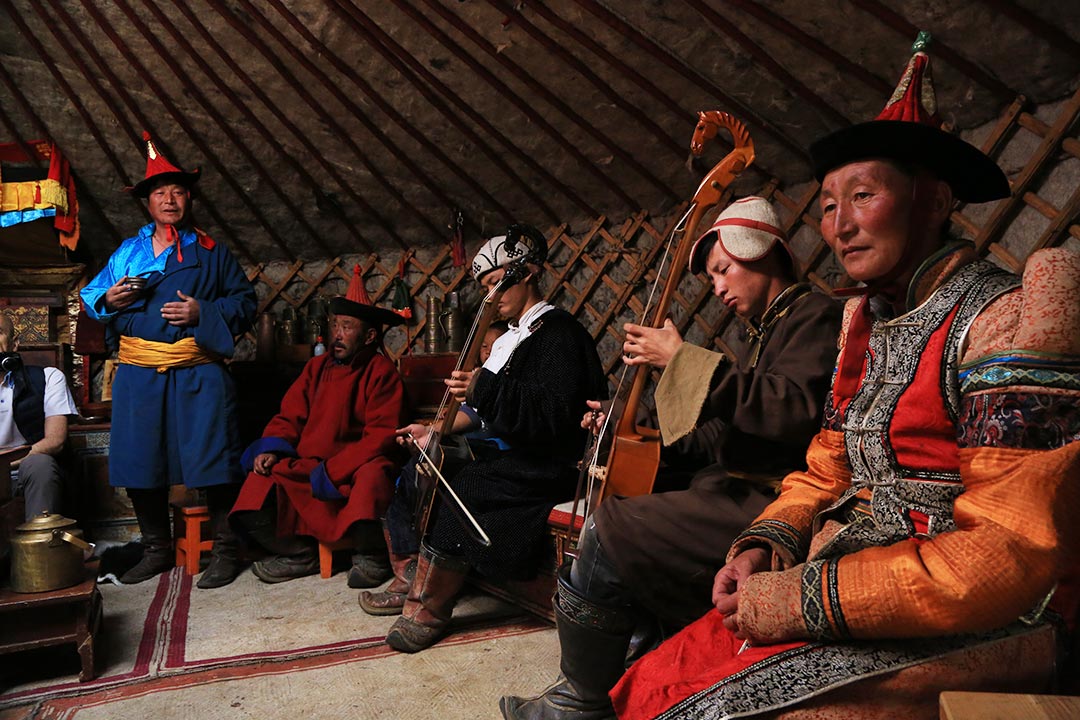“Khoomei”, commonly known as “throat singing” is a unique singing technique practiced by nomads of Mongolian and Turkic descent who inhabit the Altai mountains’ region in western Mongolia, Russian Altai and Chinese Xinjiang. It is still unknown how long the throat singing has been practiced but ethnomusicology studies suggest that Khoomei derived as an art from the attempts to mimic the sounds of natural phenomena such as wind blowing, gentle flow of a river stream and birds chirping. Khoomei is a unique vocal art and an intangible cultural heritage of Mongols. It is sung predominantly by men but it isn’t uncommon for women to practice the Khoomei as well.
The performer simultaneously produces a fundamental low tone and one or more overtones thus creating the unique spectrum of Khoomei’s sounds. The sound is created by combining movements of tongue and lips with the air pressure from abdomen and chest through throat. Each performer’s physical ability on how they combine these technique as well as their natural tones distinguish them from each other but in general there are two main types of Khoomei which are “Isgeree Khoomei” and “Kharkhiraa Khoomei”.
Isgeree Khoomei, literally meaning “whistling” has a midrange fundamental tone and is characterized by strong, flute tune-like whistling sound. Isgeree Khoomei is produced by raising the tongue and placing it just behind the teeth whilst forcing the air from abdomen and chest under great pressure.
Kharkhiraa Khoomei has a deep – almost growling sound which is related to bass singing in a Tenor choir. It is also similar to Tibetan Buddhist chants that use both vocal and vestibular sounds simultaneously to create connected sounds.
Aside from its unique harmony, Khoomei is an integral part of ancient pastoral animism still practiced today. The belief is that the spirituality of the beings in the nature is characterized not only by their shapes and locations but also by their sound. By singing Khoomei in sacred location(s), the performer connects himself to the spirits of the mountains and rivers.
In mid-20th century, Khoomei performance stages expanded beyond the higher pastures and open grasslands of western Mongolia and have grown very popular throughout the country as well as abroad. The Khoomei is distributed in as music and video recordings and played in front of broader audiences in the stages of theatres as a cultural performance.
In 2010, Khoomei was included to the UNESCO Intangible Cultural Heritage list. Today, it is one of the most captivating Mongolian traditional cultural feats among tourists visiting Mongolia.
Successful blending of Khoomei and Mongolian traditional musical instruments with heavy-metal allowed the now well-known rock band “The Hu” to stand out from the mainstream music. Their singles “Wolf Totem” and “Yuve Yuve Yu” became a great hits upon their release an topped “iTunes” and “Billboard” charts for several weeks. Each song has 39M and 57M views on Youtube respectively.






